
If you’ve always wanted a place in your home to properly store the wines you’ve been collecting and showcase them in the best way possible, this is for you.
I’ll give you an idea of how to design and build your very own wine room that’s convenient, functional, and with your personal aesthetic in mind.
This step-by-step guide will help you achieve the luxury wine cellar of your dreams, enough to dazzle your guests and showcase the bottles you hold dear.
Table of Contents
STEP 1
UNDERSTAND YOUR NEEDS AND GOALS FOR YOUR LUXURY WINE CELLAR
Before anything else, it’s crucial to assess your needs and goals. Here are the questions you need to answer to find out.
- Do you really need a wine cellar?
Does your collection truly merit a dedicated room? If you only plan to store a few cherished bottles, then a wine cabinet or refrigerator would be more appropriate. However, if you’ve amassed a small collection, shopped at wine auctions, and chased after rare vintages, then a wine cellar is in order.
- What do you want to achieve with your luxury wine cellar design?
Do you intend your wine cellar for pure storage or will you also be entertaining guests in your space? How many people do you see imbibing with you? Do you plan on storing the wine in the next five to 10 years so they can develop more complex flavors? Your goals for building your wine cellar inform whether you’ll be happy with a simple setup or if you’ll need the bells and whistles: climate control, a tasting corner, a mini bar with stools, HiFi audio system, architectural flourishes, and so on.
- Which rooms should you focus on?
Practically any room can be converted into a wine cellar with modern building materials, tools, and techniques – yes, even one with windows. So which room in your house will you turn into a wine cellar? The basement? That storage room at the back of the house? Ultimately, it all boils down to preference, convenience, and budget.
- How extensive is your wine collection?
Do you plan on expanding it over the years or keeping it small? The right amount of space is essential to a smart and functional design where everything fits perfectly. A well-planned cellar layout ensures maximum enjoyment from your investment.
- How much is your budget?
Skip this step if money is no object for your luxury wine room. Otherwise, it’s imperative to make a distinction between “must-haves” and “nice-to-haves.” Understand that you might not be able to include all of your wants, so be flexible with your plans. Seek the advice of a professional designer to identify the areas to splurge and scrimp on without compromising your vision.
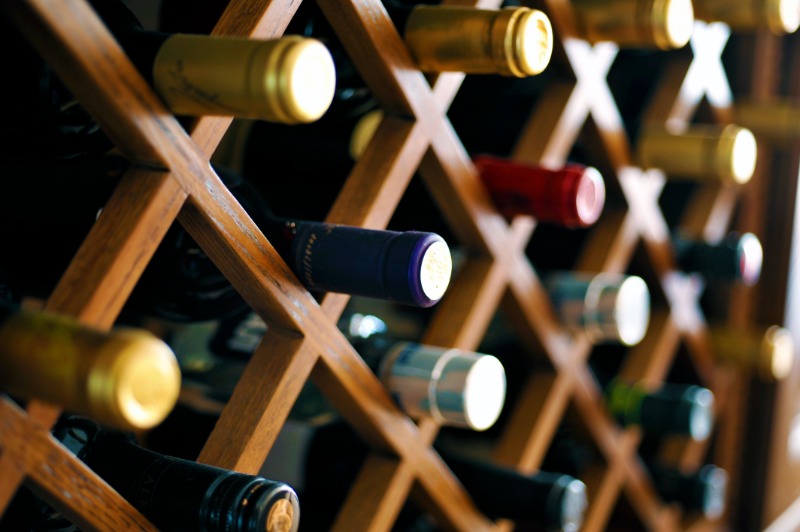
STEP 2
SELECT A ROOM FOR YOUR WINE CELLAR
Choosing the right room for your cellar requires taking into account temperature, humidity, light, and vibration. The goal is to ensure your cellar meets its ideal conditions consistently for effective, long-term use.
Here’s what’s best for wine cellars:
- Temperature: Between 45° and 65°
- Humidity: Between 55% and 70%
- Light: Zero sunlight, minimal electric light
- Vibration: Zero vibration to avoid disturbing the sediment settling process
Note that technology can now make any room in your house optimal for storing wines. With that in mind, here are my suggestions for rooms that you can effectively convert into a luxury home wine cellar.
- Basement
Basements are naturally cool and spacious. They also tend to have stable environments, and receive little to no sunlight. They are highly flexible and easy to customize with wine racks, climate control systems, lighting, and furniture. Wine cellars are meant to mimic the wine caves of old, and basements are the closest we can get to their dark and damp conditions.
- Vacant room
An empty bedroom or rarely used home office can also be converted into a luxury wine storage space. Choose a room on the side of your house that receives the least amount of direct sunlight to avoid unnecessary heat buildup within the room.
- Garage
With a little renovation, a section of a multi-car garage can be a good alternative venue for a luxury wine cellar, especially if all the rooms in the home are occupied. As long as you ensure your garage has the best possible conditions to store wine, it can be an ideal place to enjoy your bottles and even entertain guests.
- Closets
Pantries, spaces under the stairs, and empty nooks can be used as an effective wine cellar. With the addition of insulation, climate control systems, and high quality racks, these small spaces can become compact yet fully functional storage areas for your collection. They can also offer better accessibility and convenience than a basement or garage.
- Attic
Many wine connoisseurs have transformed their attics into lofty wine cellars. However, due to the amount of heat and sunlight that these rooms are often subjected to, you should be prepared with a hefty investment for insulation and cooling systems.
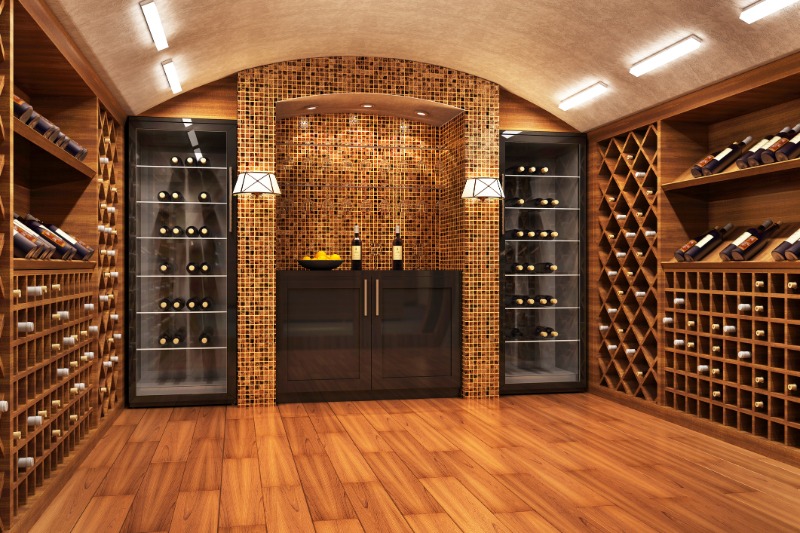
STEP 3
DESIGN YOUR ROOM
The layout is pivotal in ensuring the wine room’s convenience and accessibility. It should conform to your wine collecting and drinking habits, showcase your bottles in a visually appealing arrangement, and preserve your wines under ideal conditions.
What to consider in your design:
- Analyze the available space and flow
A well-designed layout enables you to locate bottles easily and navigate the room with no hindrance. A good basic layout is to keep the wine racks close to the walls and have your tasting area or mini bar at the center of the room.
- Allow adequate space for movement
A cramped wine cellar won’t be much fun for anybody. Leave enough space between your wine racks to avoid bumping into them and causing unnecessary vibration that could potentially dull the flavor of your vintage. If you have a sizable collection, utilize the vertical space by installing wall-mounted racks accessible by ladder.
- Organize your bottles by type and region
This makes it easy to find what you’re looking for. Keep short-term wines (those that you plan to drink sooner rather than later) close to the door or within easy reach. Label or tag your bottles so you can identify them without pulling them out from the rack.
- Consider future needs
If you plan to increase your wine cellar’s capacity, create a scalable design that can accommodate your future collection. Consider using modular racks that can be reconfigured according to your changing needs.
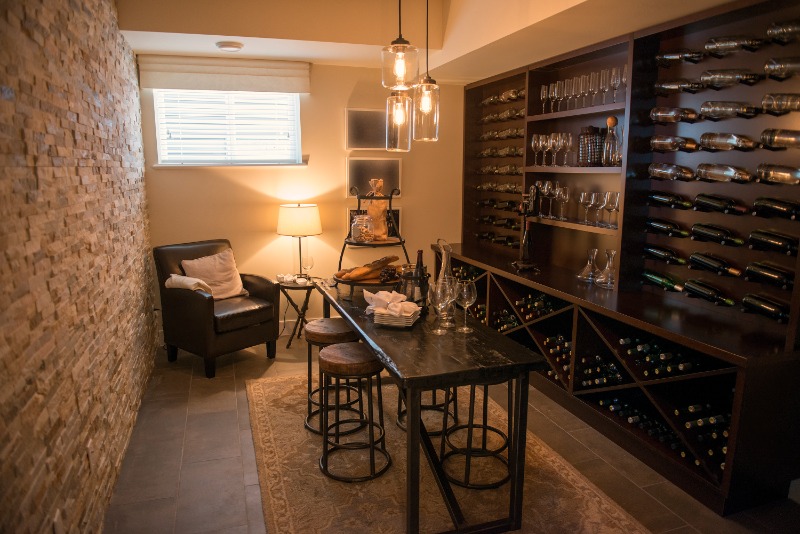
STEP 4
CHOOSE MATERIALS, FINISHES, AND FIXTURES
The right materials, finishes, and fixtures will ensure your investment is well protected. Otherwise, your room may not be able to maintain the required temperature and humidity levels. Concrete is an excellent wine cellar material, as it has inherent temperature and humidity regulation capabilities. However, you cannot leave your concrete bare. Before applying your finishes, add vapor barriers and insulation to prevent moisture from forming and collecting on the surface.
When it comes to finishes for your luxury wine cellar, hardwood is the classic choice. Wood not only looks warm and natural, it has a porosity that provides a balancing effect on interior humidity and moisture. Some of the best woods to incorporate in your wine cellar design include oak, ash, cherry, and mahogany.
Because wines are extremely sensitive to light, use LED all the way. For best results, install a dimmable lighting system that lets you control the brightness as needed. Dimmable bulbs also allow you to set the right mood when you have guests in your wine cellar.
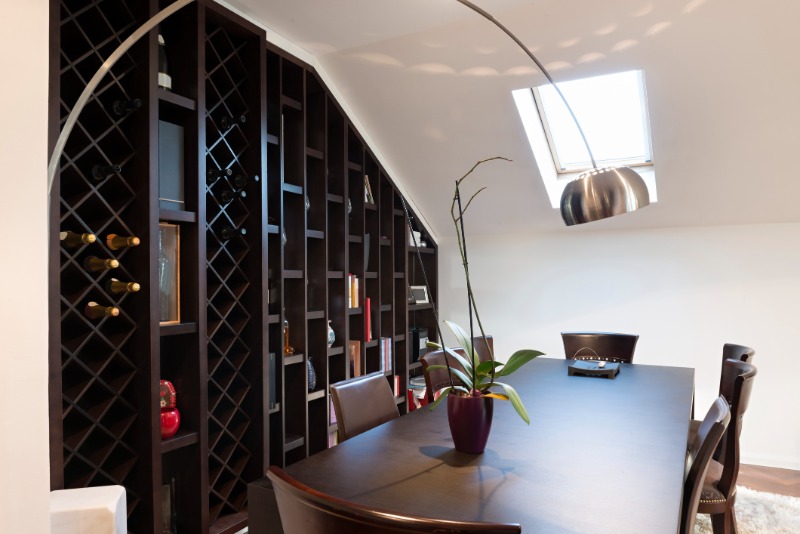
STEP 5
DECIDE ON A COLOR SCHEME
Deciding on the color scheme is a personal preference. However, it’s good to choose a palette that enhances the elegance of your wine cellar.
Here’s what certain colors evoke:
- Earth tones such as browns, beiges, and taupes impart a sense of warmth and comfort
- Dark colors can add drama, but it is best to use them sparingly
- Neutral shades of white, gray, and black can serve as accent colors that don’t clash with the wood finishes and bottles on display
With color selection, your primary goal is to create harmony between your bottles and the room. You should also take into account your home’s overall design. Opt for colors that complement the rest of your interior decor for a seamless look.
STEP 6
PICK YOUR WINE RACK
Just as wine comes in numerous different types, so do wine racks. Generally speaking, wine racks can either be freestanding or installed. Choose freestanding if you want a more flexible and customizable setup. Go with installed units if you want a more bespoke, stable, and permanent layout. Between these two main types, there’s a wide variety of styles to choose from.
Here are the most common styles:
- Tabletop or countertop rack
This type is a freestanding, small-capacity rack that can hold up to 12 bottles of wine. It can be set on top of a table or cabinet.
- Floor rack
This is a cabinet-like vertical rack that’s sturdy and stable enough for freestanding or positioning against a wall. Large floor wine racks that resemble traditional furniture pieces can hold 50 bottles or more. A floor rack is a great option if you have a collection in the hundreds.
- Wall-mounted wine rack
In addition to holding bottles, this type of rack can also be used to accent bare walls. Some wall-mounted racks can hold up to several dozen bottles. However, they can’t hold as much as floor units due to weight limitations and the risk of dislodging from the wall.
- Hanging rack
This type of rack can be attached to ceilings or cabinet bottoms. More for aesthetic than practical purposes, hanging racks are only meant to hold a limited number of wines for easy access.
- Cabinet rack
This type of rack is best for those who prefer enclosed storage for their wines. Cabinet wine racks can be fully enclosed or feature glass panes that offer both storage and display functionality.
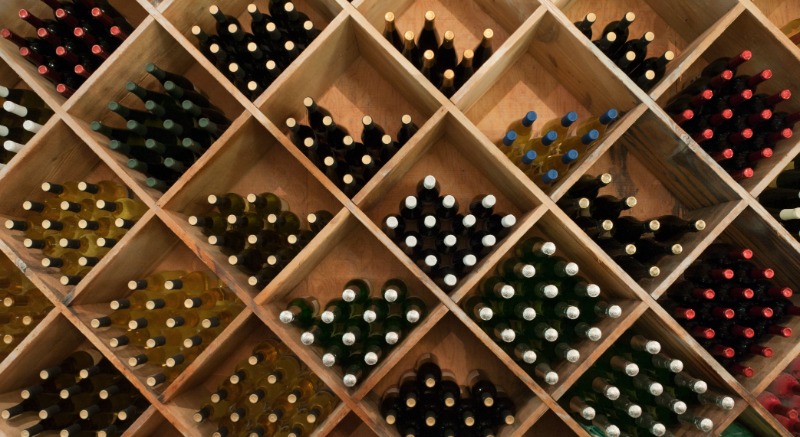
STEP 7
CONTROL THE CLIMATE
For casual wine enthusiasts, the ambient temperature of a basement will be enough for storing wine. Serious collectors, however, will need a more calibrated cooling system. These systems are meant to maintain the perfect temperature and humidity levels to ensure the wines achieve their best flavor, texture, and balance.
Not to be confused with regular HVAC units, wine cellar climate control systems are specialized air conditioning systems made specifically for wine storage.
Climate control systems for wine come in three types:
- Ductless split types consist of an indoor unit (evaporator) and outdoor unit (condenser). They can handle large cellars and offer excellent cooling flexibility.
- Ducted split types incorporate a network of insulated ducts to distribute cool air evenly throughout the cellar. The addition of ducts make them costlier to install and maintain than ductless split types.
- Self-contained or through-the-wall systems are a great option for smaller wine cellars. These units are easy and cost-effective to install – just plug and play. However, they can be quite noisy due to the condenser housed inside the wine cellar. They also tend not to be as precise with temperature and humidity control as split and ducted units.
When deciding on a wine cellar cooling system, factor in the size of your room, the type of wines that you have, the level of insulation you require, and your budget. Consult a luxury wine cellar specialist for the best option for your needs.
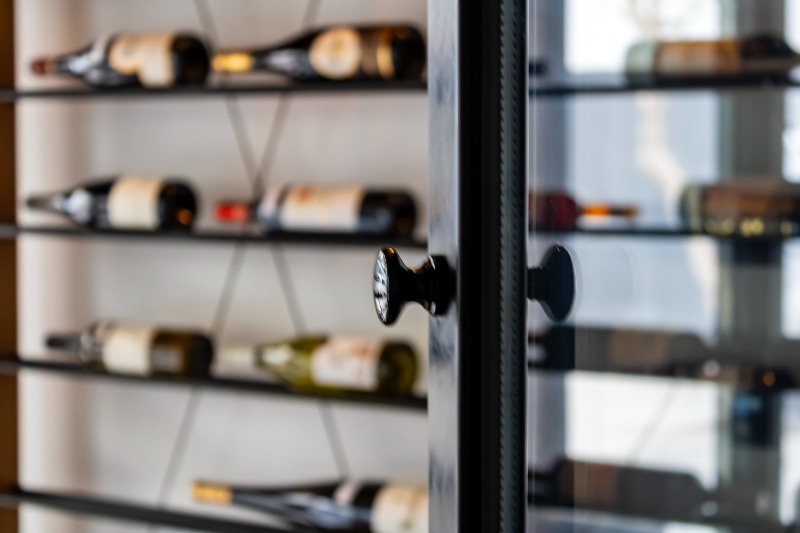
STEP 8
DECORATE
Decor is how you elevate your cellar from merely being a room of dusty bottles to a realm of luxury.
Start with the walls and develop a theme with the walls as your anchor. You can embellish your four corners with artwork, painted tiles, custom trims, murals, or stained glass if you so desire.
Next comes the furniture. Tasting tables and chairs can be specially selected or custom-built to complement the overall luxury wine cellar design. For a uniform look, choose pieces that match the wood and color of your racks. Ceilings can be adorned with rustic pendant lights or chandeliers for a timeless look.
Designing a luxury wine room is more than just aesthetics. It’s about creating a space where your wines can achieve their full potential for your full enjoyment. The use of high-end materials, special finishes, high-tech cooling systems, and luxury decor all work hand in hand to make your room the perfect sanctuary for your collection.
With careful planning, you can create a functional luxury wine cellar design that reflects your appreciation for the finer things in life.

Looking for a luxury home with a wine cellar in Fairfax County, VA? Or would you like to customize your own in any of Fairfax County’s spacious homes for sale?
Work with me, a Realtor with a passion for my craft. During the nearly two decades I’ve been helping buyers and sellers navigate the ups and downs of the Northern Virginia real estate market, I have helped more than 100 clients realize their real estate goals. They include repeat customers and investors with whom I’ve conducted more than 15 transactions.
Call me, Dwight Morris, at 703.298.8421 or send me an email here. Let’s find a home for your precious collection now.


